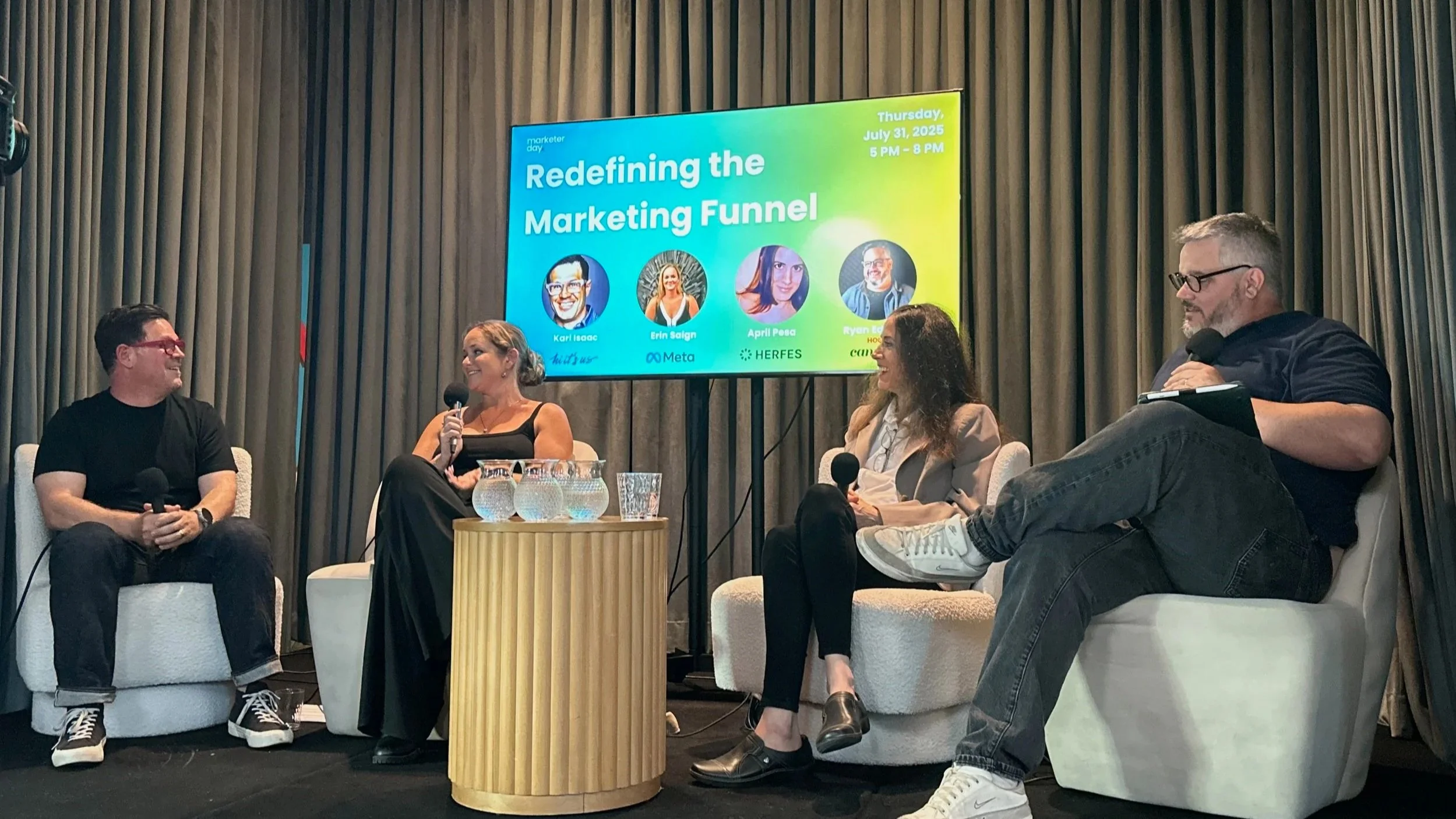Redefining the Funnel: From Brand to Creators to Conversions - Insights From Our First MarketerDay
Trust is the new currency, and creators are the new launchpad.
Venice Beach doesn’t usually play host to quiet inflection points in marketing strategy. But that’s exactly what happened at the inaugural MarketerDay at The KINN.
The event wasn’t built around hype. It wasn’t about product launches or trend forecasts. Instead, it brought together a cross-section of creative leads, strategists, platform experts and brand veterans. People doing the real work. And they came together to ask one central question:
Is the marketing funnel still working?
The short answer, echoed again and again throughout the day, was no. The longer answer revealed something deeper. Brands today aren’t navigating an evolution of the funnel. They’re operating in an entirely different system.
From Adobe to Meta to TikTok Shop, the people in the room weren’t debating how to adapt their funnel. They were building new frameworks entirely, rooted in community, creator-led trust and real-time behavior. The shift is already underway. And if you’re still thinking in steps, you’re designing for a reality that doesn’t exist anymore.
A Funnel Built for Real Behavior
True marketing strategy starts with empathy and clarity, not clever copy. This is at the core of Camino5’s consumer-journey-first approach. Funnels assume steps. Today’s behavior ignores them.
April Pesa from Professor Fest described it plainly: “The funnel isn’t compressing. It’s collapsing.” On TikTok Shop, users go from discovery to purchase in seconds. Experience, desire and action happen simultaneously. Think of it like marketing improvisation. If a single moment can convert, you don’t design a funnel. You design for the moment itself.
It’s no longer about delivering messages in sequence. It’s about being discoverable in real time, credible in context and seamless at checkout.
Looped Strategy vs. Linear Control
At Adobe, Karl Isaac saw this coming years ago. He shifted how the brand engaged, with creators openly remixing Adobe identity through its Adobe Mix initiative. The point wasn’t rebellion. It was durability.
Isaac explains: “You don’t own the brand anymore. Your customers do.” That reframes everything. Funnels assume scripted movement. When brands build loops instead, they start with trust and let the system work its way around.
Instead of targeting through one-to-many statements, the strategy becomes participatory. Creator collaboration, remixable campaigns, community feedback. Funnels restrict access. Loops create belonging and momentum.
Creators Are the New Gateway
If brand awareness once launched the funnel, creators do now. Erin Saign from Meta puts it well: “You’re not just tapping into impressions. You’re borrowing trust.”
That quote nails the shift. Trust built over time between a creator and their audience far outweighs any campaign view. Brands can’t replicate that. They can only participate.
But participation doesn’t mean losing control. Saign’s warning is clear. If you dictate too much, the signal breaks. Successful collaborations give creators direction without dictating their voice. That’s how you build relevance, not force it.
Participation Over Precision
Traditional funnels assume control: rigid messaging, pre-approved execution, fixed localization. Instead, Camino5 advises that participation is a competitive advantage. You don’t replace structure. You reconfigure it.
You trust creators. You let go of sequence. You hire restraint over repetition. Adobe found that giving audiences a stake in the brand narrative returned profound outcomes. Pesa shaped culture similarly at Mondo Media. Fan-generated content around Happy Tree Friends exceeded studio viewership and revenue.
It’s not about control. It’s about curation.
Structure Still Delivers
Some marketers worry open loops lead to chaos. That’s a misunderstanding. Structure matters. But structure built for participation looks different.
Think of Dove’s Real Beauty ethos. Clear brand values combined with flexible expression. That’s what Camino5 calls freedom within a framework. It ensures messages are authentic and aligned without being rigid.
It takes clarity, not control. Strategic design, not scripted execution.
Why AI Can’t Carry the Funnel
Generative AI is transformative, but it can’t replace nuance. Isaac puts it simply: “If you use the same tools, you’ll sound the same.” AI scales content but doesn’t build empathy or context. It elevates speed, not uniqueness.
That means AI should support design, not replace it. Let AI produce drafts, but let humans curate resonance. Build systems, not content factories.
Customer Support Is Bottom-Funnel Strategy
Funnel models end at purchase. That’s where the work begins. Good support — efficient, empathetic, responsive — re-engages someone in the experience loop. It converts through care, not just transaction.
Camino5 encourages teams to elevate support from cost center to brand moment. Great service lowers churn, builds loyalty and turns customers into creators themselves.
What the Funnel Got Wrong
The problem wasn’t the funnel. It was our faith in it and the control it offered. Funnels forced predictability where none exists. They masked nuance behind stages. They elevated conversion over connection.
Today’s consumer journey is decentralized. It is emergent, not engineered. People search on TikTok, ask creators in comments, consult AI summaries and buy through links in live video. The funnel can’t keep up.
But influence loops can. They scale on trust, relevance and empathy.
The first Marketer Day wasn’t It was a diagnosis of what’s not working, it was a celebration of what’s working and how to reemagine the funnel into on that connects bradns to people, instead of just selling to them.
The future of marketing is less about orchestrating messages and more about designing participation. Less about acquisition and more about earned engagement. The brands that win won’t be those with the biggest budget. They will be the ones that understand how to move inside modern attention flows with empathy, flexibility and speed.
This is the loop. It’s already running. You’re either in it or forgotten by it.

